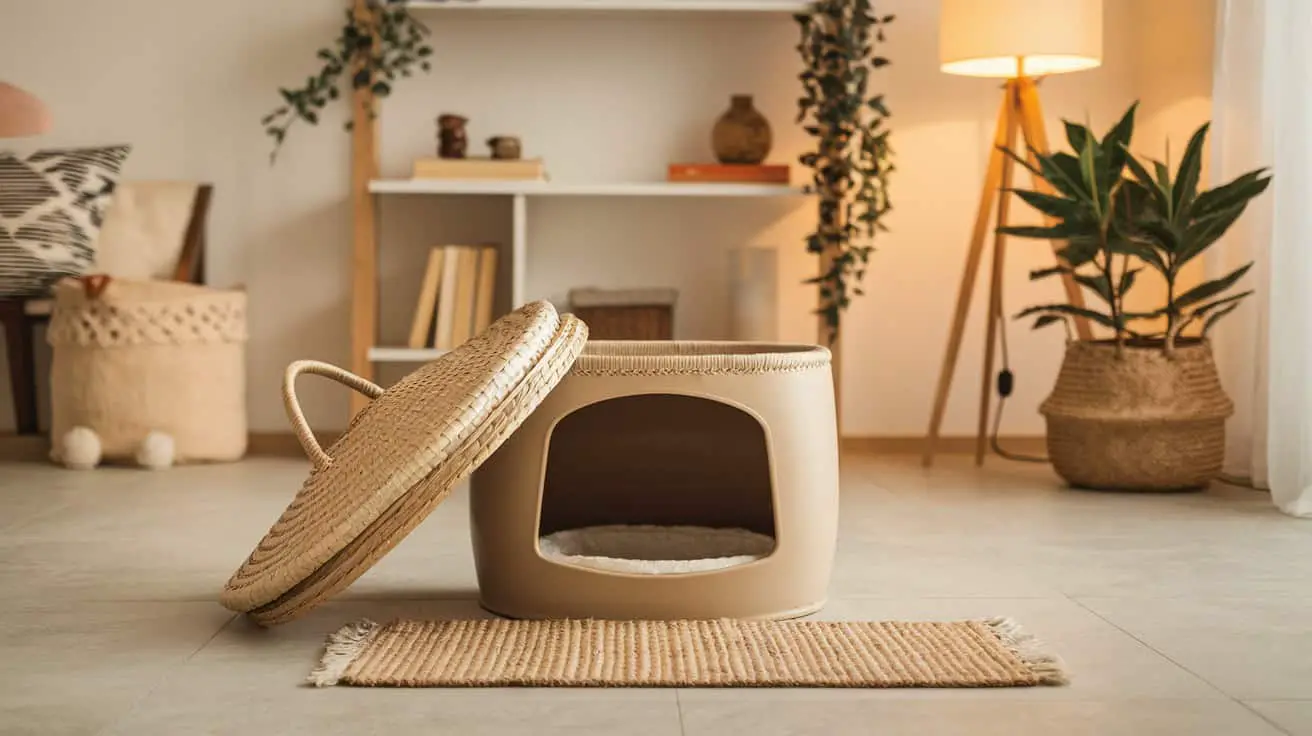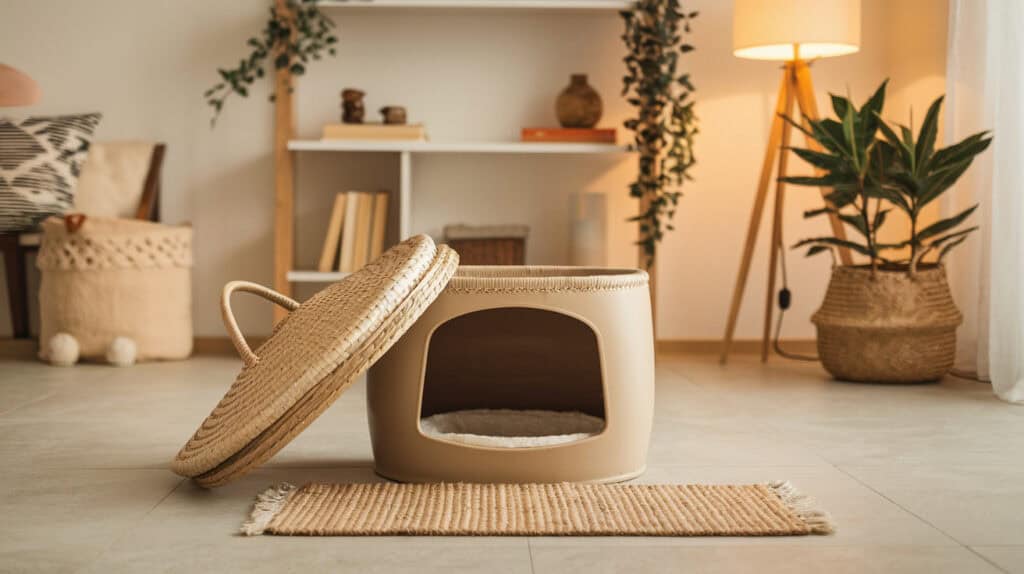
If you’ve ever tripped over a plastic litter tray at 3am or had guests spot that corner before they’ve even taken their shoes off… you know the struggle. Litter boxes — necessary? Yep. Cute? Not so much. Especially when you live in a smaller space or your cat’s taste in decor leans more “clumpable convenience” than “Parisian chic.”
I remember the day I finally admitted the old grey box behind the armchair was kind of killing my vibe. It smelled fine (thanks, baking soda), but it just sat there… judging me. So I went down the rabbit hole of litter box furniture hacks, DIY enclosures, and hidden cat cubbies. And honestly? Life got so much prettier.
Whether you’ve got one sneaky tabby or a whole feline entourage, these ideas are here to help you hide that litter life in plain sight — with style. Most of them are renter-friendly, budget-friendly, and all approved by my two test subjects (Tofu and Crumbs, who both refuse to pee in anything that’s not fabulous).
Convert a Basic Storage Cabinet into a Hidden Litter Box
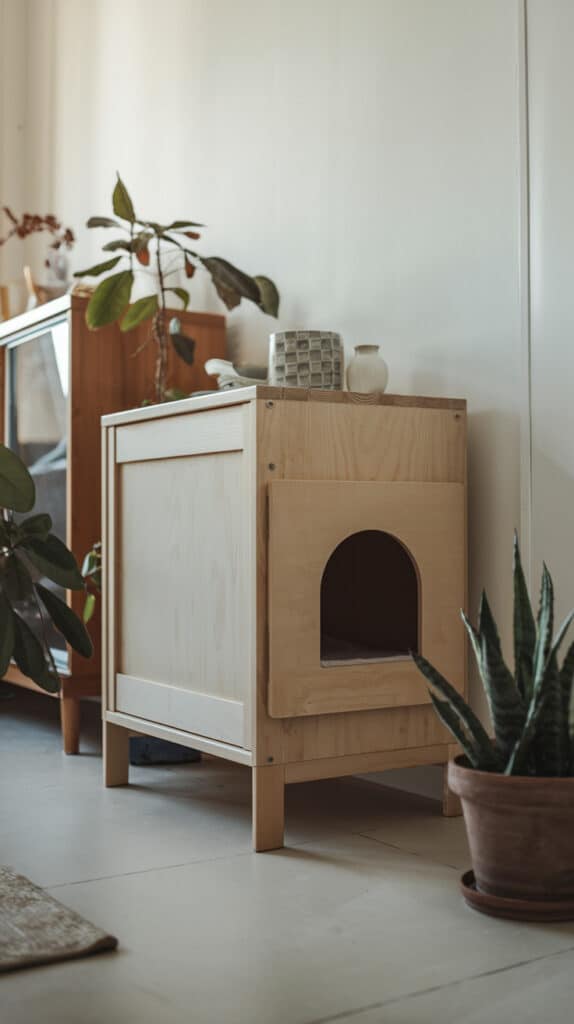
Got a plain old cabinet gathering dust? Maybe it used to hold shoes, books, or random kitchen stuff? Time to give it a glow-up and turn it into the ultimate hidden cat litter box — no brand names required.
Start with any solid storage cabinet that’s at least 16–18 inches deep. Bonus points if it has doors or a drawer-style front. Use a jigsaw or hole saw to cut a smooth cat-sized entry hole into the side or back panel (depending on where you want access). If it’s made of MDF or plywood, go slow to avoid splintering, and sand the edges for safety.
Inside, place a medium litter tray with a low-tracking mat in front. Drill 3–4 small ventilation holes in the back (use a spade bit if you’ve got one), and line the base with peel-and-stick tiles or shelf liner for easy cleanup. For extra polish, paint or wrap the whole thing to match your room — think faux woodgrain contact paper, matte black, or whatever suits your space.
Top it off with a plant, some books, or even your WiFi router, and boom: it’s a fully disguised cat bathroom that blends in. Perfect for small flats, stylish living rooms, or anyone who’s tired of staring at plastic trays.
DIY Litter Box Bench for the Entryway
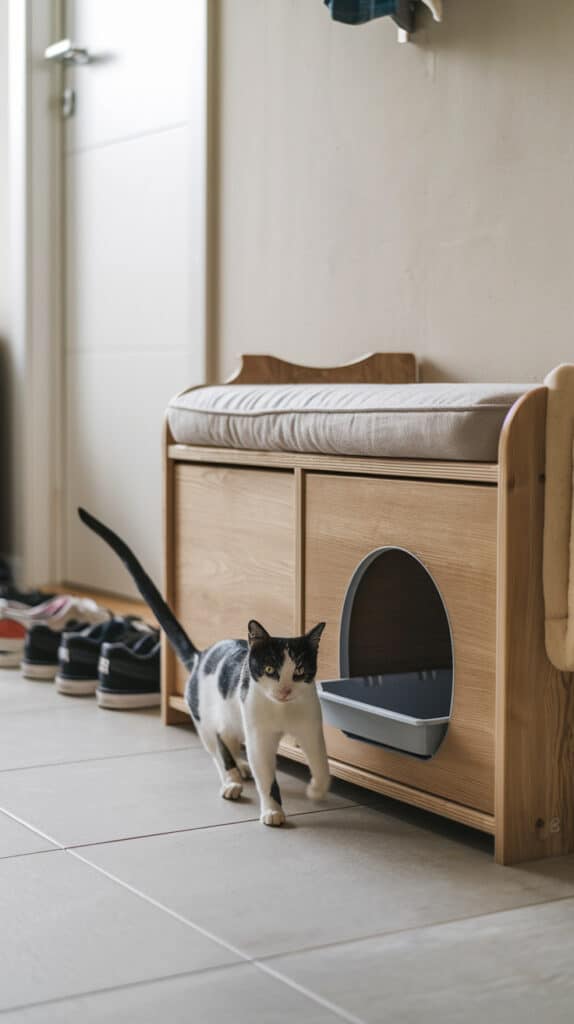
One of my favourite tricks is turning the entryway bench into a secret litter box hideaway. It looks like a regular wooden bench, maybe with a comfy cushion on top, but inside? A whole little cat bathroom setup. Hinged lids or magnetic doors make it easy to clean, and if you add a storage basket next to the litter tray, you’ve got room for liners, scoops, and air freshener too.
This works best with wood-style storage benches — something that’s already hollow or has a big interior. You can buy one secondhand and cut a side opening, or build it from scratch using plywood panels and corner brackets.
Perfect for studio apartments or homes where the litter box has nowhere to go except the hallway. Plus, guests will never know… unless your cat dramatically emerges mid-visit.
Enclosed Side Table Litter Box for the Living Room
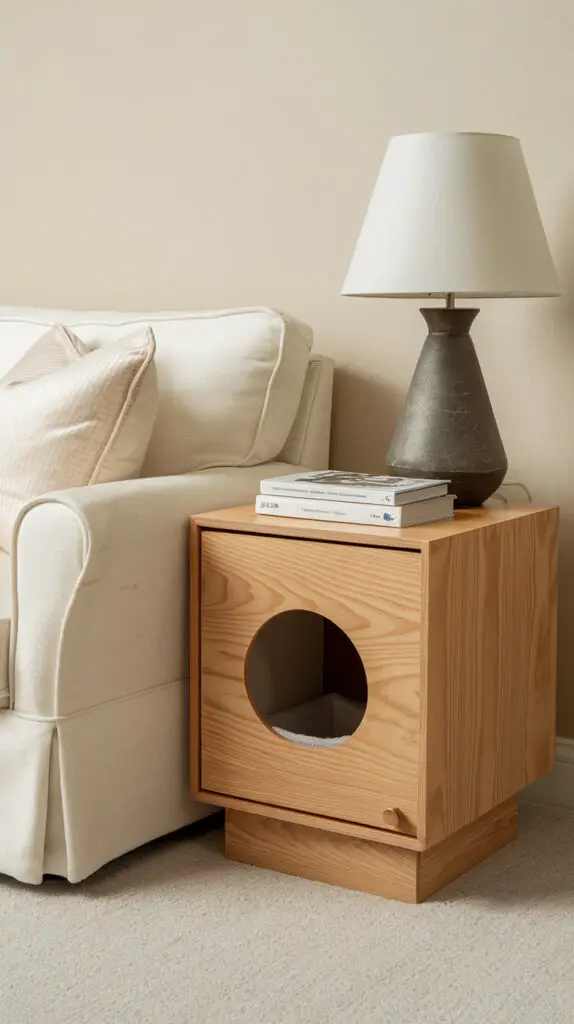
Let’s be real — most of us have a little side table near the couch that holds random remotes and half a glass of water. But if it’s got an open back or cabinet door? You’ve got yourself a hidden litter box opportunity.
Choose a table with enough depth and height for a medium-sized tray, then modify the side panel to create a cat door. Add in a small motion-sensor light if you’re extra (I did… and yes, my cat now poops under a spotlight).
The trick here is matching the vibe of your living room. Keep it modern with black or white paint, swap the handles to something brass or matte, and stack books or a lamp on top. A candle (safely out of cat range) helps too.
This solution keeps things close to the cat’s zone without ruining your design — and that’s kind of the dream.
Under-the-Sink Litter Box for Tight Apartments
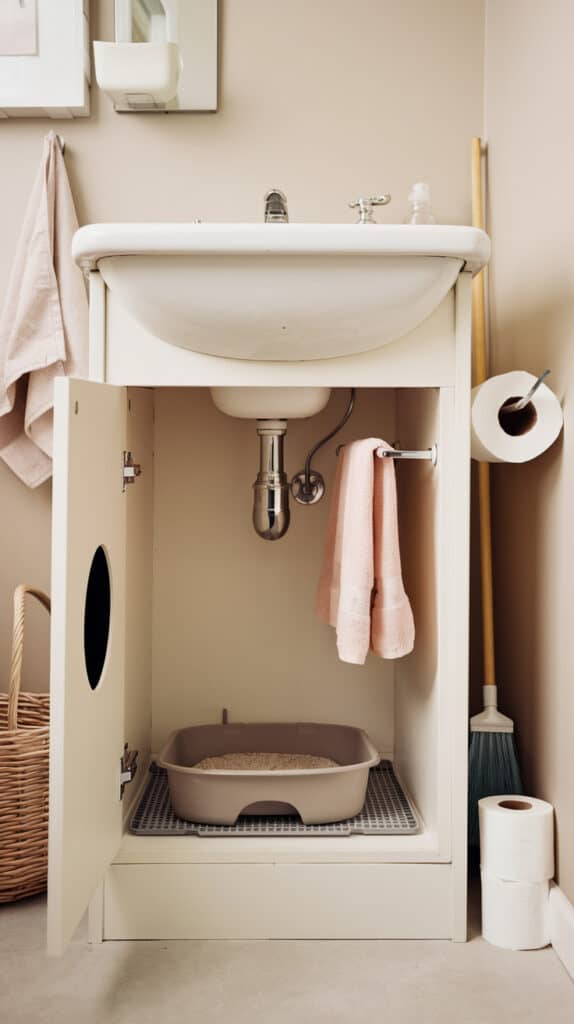
If your bathroom vanity or laundry room sink has an under-cabinet area, that’s prime real estate. You’ll need to check that there’s enough room for the tray (and that nothing leaks down there), but otherwise, it’s an easy and invisible fix.
Install a magnetic child-proof lock so your cat can’t push open the doors (or your toddler, if that’s a thing), and cut a neat round hole on the side for access. Line the bottom with a plastic mat in case of spills and keep the litter scoop tucked in a corner or hanging from a hook.
If you’re fancy, you can paint the interior a fun colour or use waterproof wallpaper to make it less utility-cupboard, more boutique-cat-lounge. And if you’ve got a pedestal sink? No worries — try a custom fabric skirt around the base to hide a shallow litter tray.
Hidden Litter Closet with a Cutout Door
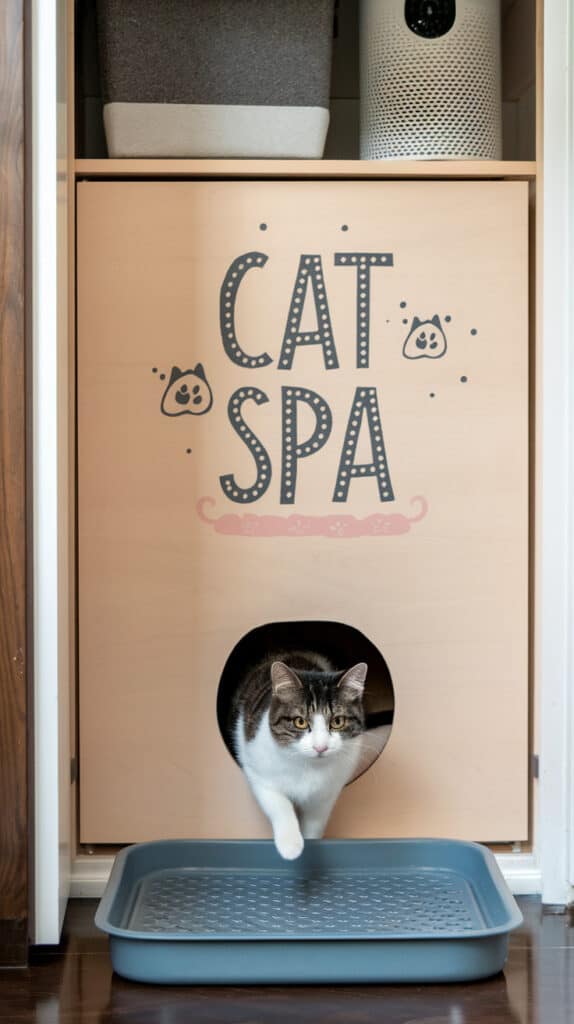
Closets aren’t just for coats anymore. If you’ve got a hallway or utility closet you don’t use daily, you can convert the bottom portion into a hidden litter nook. Just add a cutout or flap door at the base for your cat, and use the upper space for storage like normal.
It helps to put down a waterproof tray or removable mat, especially if the closet is carpeted. You can even use peel-and-stick tiles on the base for easy cleaning.
Add a battery-powered air purifier or deodouriser and label the outside something cute like “cat spa” if you’re feeling cheeky. This one is great if you need everything completely out of sight — it’s a full transformation from storage space to litterbox palace, and it makes use of square footage you might’ve forgotten about.
DIY Sideboard Litter Lounge for Multi-Cat Homes
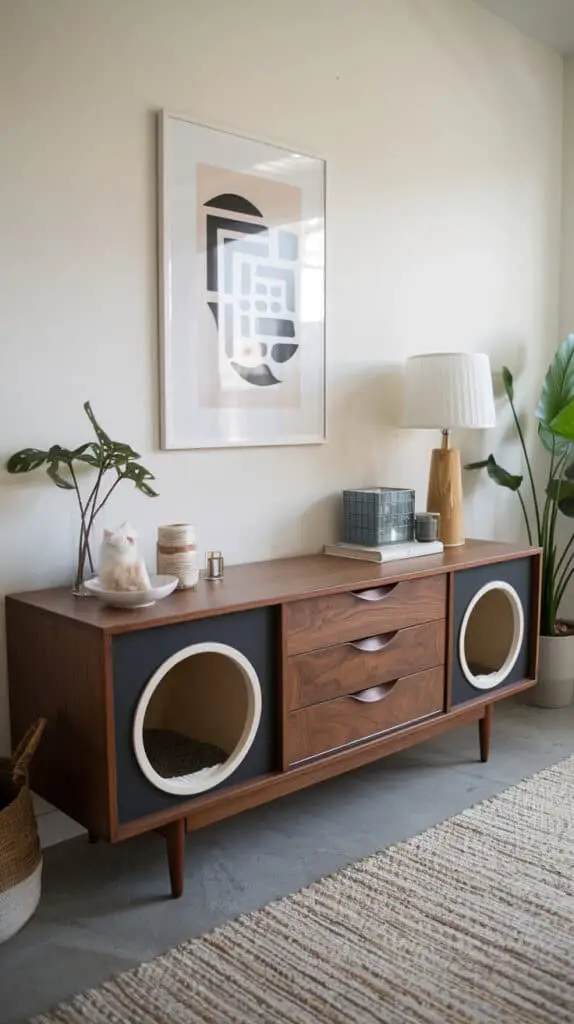
If you’ve got more than one cat, you probably have more than one box — which means more stuff to hide. A long, low sideboard (like the kind used under a TV or in a dining room) is perfect for this. Cut entry holes on either end so both boxes have their own exit routes (some cats like privacy), and space them apart inside the cabinet.
Line the interior with waterproof mats or tray inserts, and keep litter scoop supplies in the drawers. You can even drill a small fan vent in the back or add baking soda pouches inside to keep things fresh.
Choose a piece of furniture with a modern or mid-century vibe to make it feel like a design choice, not just a workaround. And if your cats are picky? Leave the doors cracked slightly for better airflow while they get used to it.
Litter Box Hidden in a Plant Cabinet
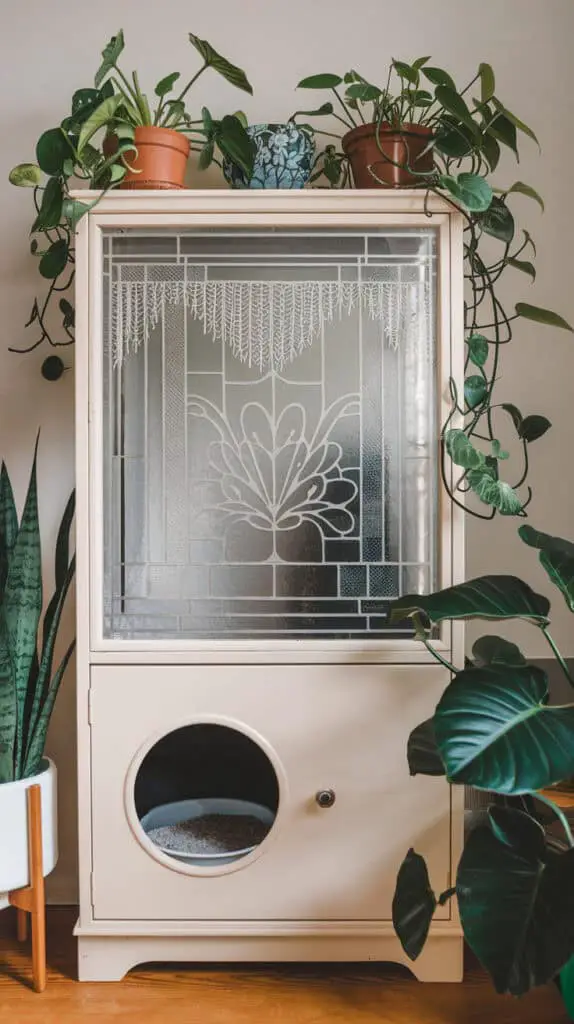
Yes, this is exactly what it sounds like. A litter box hidden in the base of one of those indoor plant cabinets or greenhouse-style shelving units. This one’s a little whimsical, but surprisingly practical.
Use a large cabinet with glass doors on top and a closed base below. Decorate the top like a mini jungle with potted plants (faux or real — but keep them non-toxic), and use the bottom cupboard for the litter area.
Cut an entry in the side or back, and fill the interior with a tidy box, litter mat, and deodoriser. Add a cute curtain or ventilation holes disguised as design features.
It’s perfect for those of us who want everything in the living room to have a little aesthetic flair — even the cat toilet.
Pallet Wood Litter Hutch
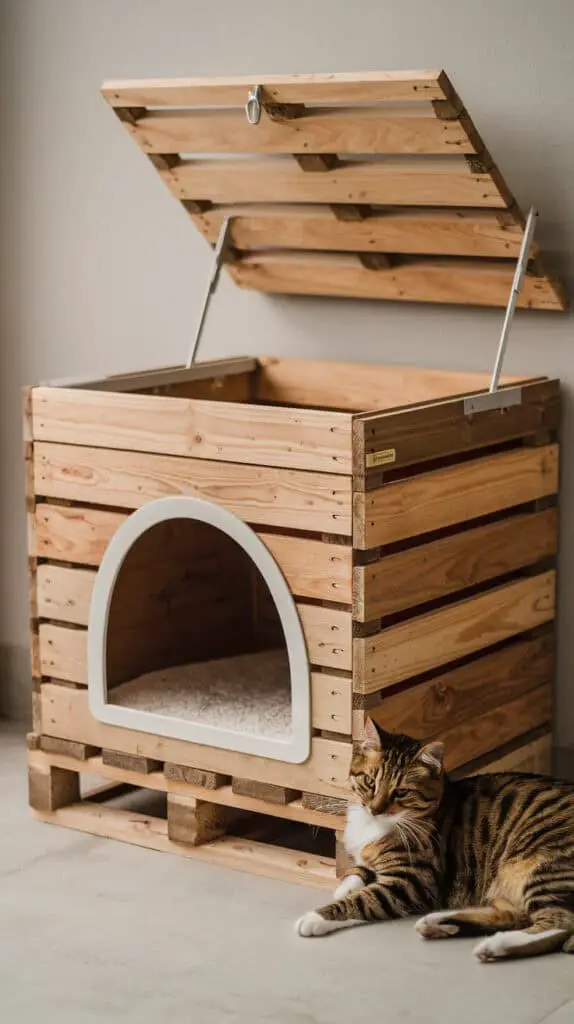
If you’re the DIY kind of person with a drill and a Pinterest board full of weekend projects, this one’s for you. Build a litter hutch out of reclaimed pallet wood or leftover plywood. You can make it any size you want, but I recommend keeping it large enough for easy scooping and to fit your cat comfortably.
Add a hinged top for cleaning, a front entry cutout, and maybe some slatted sides for ventilation. Sand it smooth and seal it if you’re using raw wood. Paint or stain it to match your furniture and it becomes part of your home, not something you’re trying to ignore.
Bonus points if you make a matching feeding station or cat perch out of the leftover wood scraps. Rustic, functional, and way cheaper than buying “cat furniture” from a catalogue.
Litter Tray Hidden in a Rolling Drawer
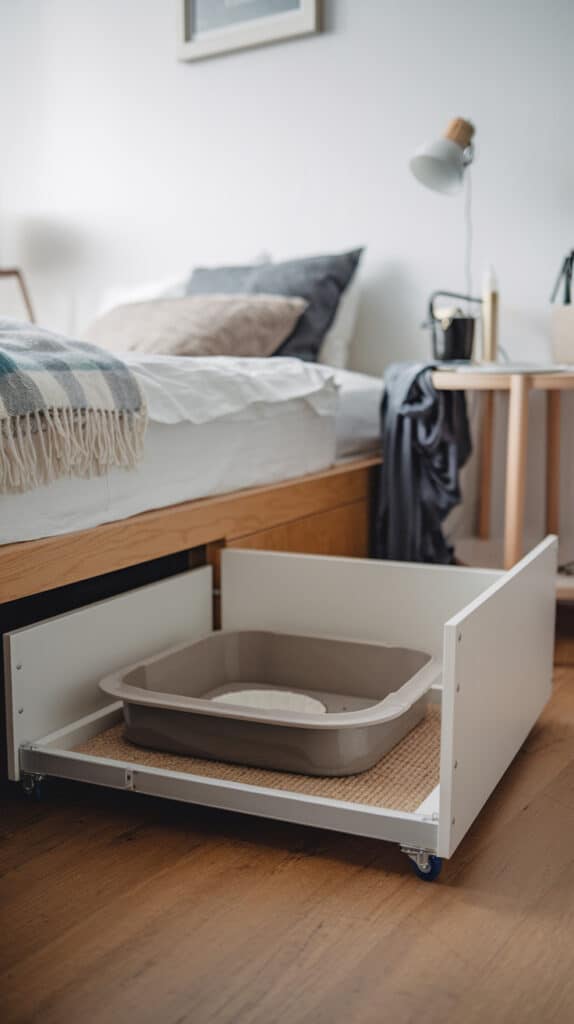
For small spaces (or just smart ones), hiding a litter box in a drawer under your bed, inside a bench, or in the bottom of a wardrobe is genius. Build or buy a shallow drawer on wheels, add a mat or low litter tray, and tuck it underneath.
You can pull it out to clean, then slide it back in. This works especially well with platform beds or those modular bench units people put in dining nooks.
If your drawer doesn’t come with ventilation, just be sure to pull it out a few times a day or add charcoal filters nearby. For extra flair, line the inside with peel-and-stick tiles and stencil your cat’s name on the drawer front. They’ll never know they’re royalty living in a storage hack.
Laundry Room Litter Hideaway with a Curtain
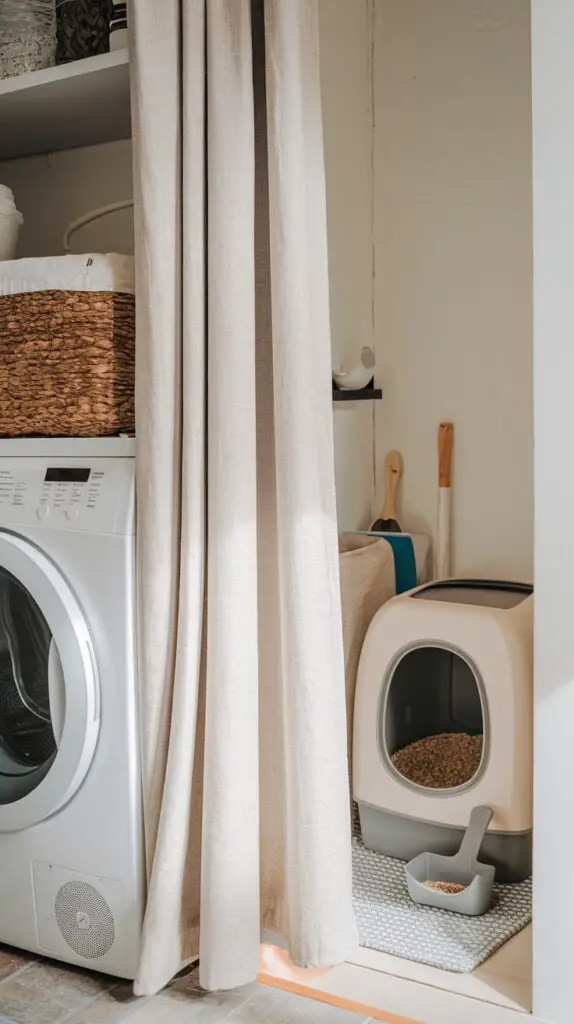
Sometimes the simplest fix is the best one. If your washer/dryer is in a corner or closet space, just add a small curtain across one side — and slide a litter tray right behind it.
Use a tension rod or stick-on hooks to hang a little linen panel, and tuck your litter tray back where it’s out of view. Easy to access, easy to hide, and no tools required.
It works especially well if your laundry area already has a utility shelf or storage basket above. The key is keeping it clean and fresh, so pop an air freshener nearby and sweep daily.
I used this setup in my first flat and honestly? It worked better than anything fancy. It’s renter-friendly, budget-friendly, and still gives your cat a quiet little nook to do their thing.
Final Thoughts
Let’s be honest — litter boxes aren’t the most glamorous part of having a cat. But hiding them? That’s where the fun begins. Whether you live in a tiny apartment, a full family home, or somewhere in between, there’s always a creative way to blend your cat’s needs with your own style.
I’ve lived with makeshift boxes behind curtains, under benches, even once inside an old IKEA cabinet with a broken leg (don’t ask). And while none of them were “perfect,” they all worked — and my cats didn’t seem to mind one bit.
The main thing is: it’s not about having the fanciest solution, it’s just about making sure your space works for both of you. And if that means cutting a hole in an end table or turning a laundry closet into a litter cave, well… that’s kind of the joy of DIY, isn’t it?
So pick one that fits your home, try it out, tweak it later. Your cat probably won’t thank you. But they’ll use it. And that’s all the thanks we really need.

